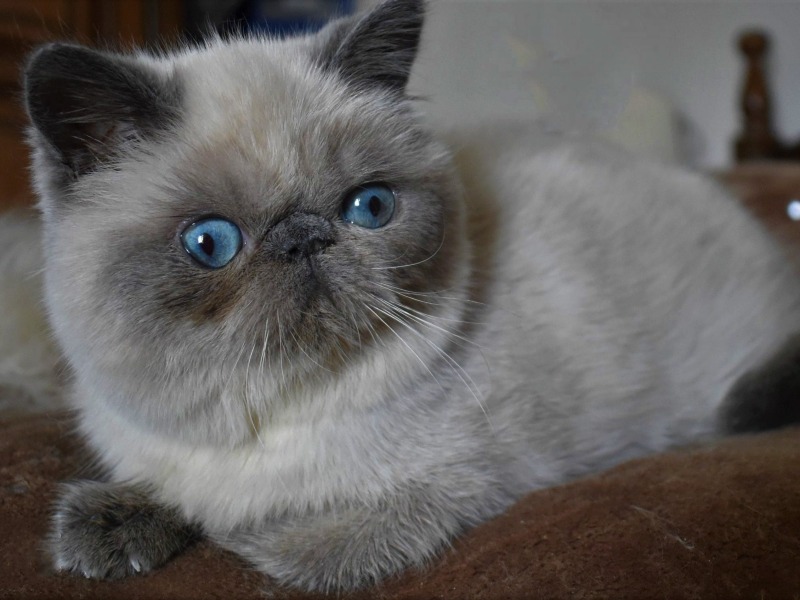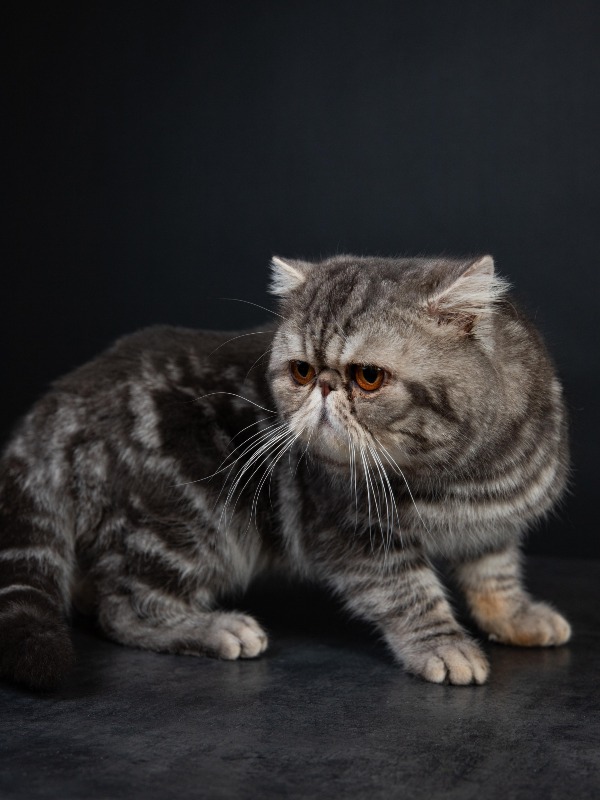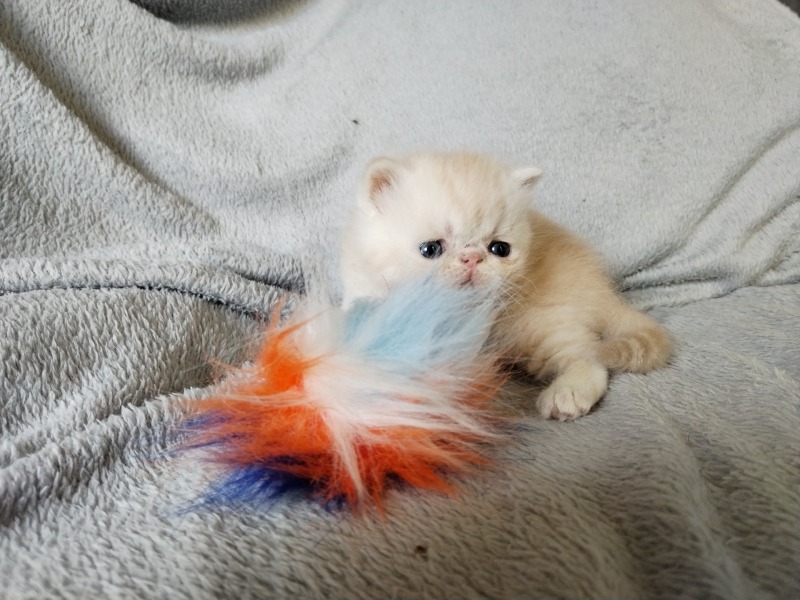Exotic short hair
Welcome to our page dedicated to the breed of cat exotic short hair!
Here, you will find all the useful information about exotic short hair. This descriptive profile will allow you to discover the aspects of this breed. You can notably consult information about the average price, monthly and annual upkeep expenses, their health, name ideas, as well as their official recognition by competent authorities.
Explore this page to discover everything you need to know.
Overall description of the breed
The Exotic Shorthair is a fascinating cat breed that has gained worldwide popularity for its unique appearance and gentle character. This breed is the result of a cross between the Persian and other short-haired breeds, made with the aim of retaining the Persian's characteristic look while eliminating the need for intensive maintenance of its long coat.
The history of the Exotic Shorthair dates back to the 1950s and 1960s, when breeders began crossing Persians with breeds such as the American Shorthair and British Shorthair to obtain the short coat while preserving the Persian's flat face and stocky body. These efforts led to the emergence of the Exotic Shorthair as a distinct breed.
The ancestors of the Exotic Shorthair are the Persian, the American Shorthair and the British Shorthair. The result of these crosses is a breed with a short, dense, soft coat and an adorable, charming appearance.
The Exotic Shorthair's morphology is characterised by a stocky, well-muscled body, a broad, round head with a flat nose and large, expressive eyes. Its ears are small and rounded, and its tail is short and thick. The Exotic Shorthair is medium to large in size, with a compact body and elegant appearance.
In terms of colour, the Exotic Shorthair comes in a wide variety of patterns and shades. Exotic Shorthair cats can be found in a wide range of colours, including tabby, bicolour, unicolour and many others. This diversity of colours adds to the appeal of this breed.
The average weight of the Exotic Shorthair is between 4kg and 6kg (8.8lb and 13.2lb), although some individuals may weigh slightly more or less. In terms of height, the Exotic Shorthair averages between 20 and 25 cm (8 to 10 inches) at the withers.
The Exotic Shorthair's founding breed club is the American Cat Association (ACA). The breed standard was established in the 1960s, and in 1966 the Exotic Shorthair was officially recognised as a distinct cat breed by the American Cat Association (ACA).
The Exotic Shorthair is widely recognised and appreciated throughout the world for its friendly, peaceful nature. It is a gentle, affectionate and calm cat that gets on well with children and other pets. The Exotic Shorthair is also known for being intelligent and playful, but it also enjoys relaxing and cuddling with its owners.
In conclusion, the Exotic Shorthair is a charming and adorable cat breed, the result of cross-breeding between the Persian and other short-haired breeds. Its short, soft coat, combined with its gentle, friendly character, make it an ideal companion cat for many homes around the world. With recognition from world-renowned cat organisations, the Exotic Shorthair continues to grow in popularity and win over cat lovers with its endearing personality and distinctive appearance.
Awareness of acquiring an animal
Each animal is a sensitive being, deserving love, attention and care.
When you choose to adopt an animal, you take on the responsibility of ensuring its health and well-being throughout its life.
To learn more about animal welfare, we invite you to consult our FAQ by clicking the button below:
Origins
The Exotic Shorthair was created in the 1950s by crossing Persians with American Shorthairs and other short-haired breeds to introduce new colors and patterns into the Persian. The goal was to produce a cat with the appearance and temperament of the Persian but with a shorter, easier-to-maintain coat. What began as an experimental breeding program resulted in a distinct breed that combines the best of both worlds.
History
The Exotic Shorthair breed quickly gained popularity due to its easy-to-maintain short coat and friendly nature, inherited from Persians. Officially recognized in the 1960s, it has become one of the most beloved breeds in cat shows and households. The Exotic Shorthair is often described as having the gentleness and dignity of the Persian, but with a more playful and active side.
Standard
The Exotic Shorthair has a robust and muscular body, with a broad and round head, full cheeks, a short nose, and large, round, expressive eyes. Its ears are small and rounded. The coat is short, dense, and plush-like, giving the impression of touching silk. Although all colors and patterns are accepted, the quality of the coat and body structure are essential to meet the breed standard.
Physical characteristics
With its compact and muscular physique, the Exotic Shorthair shares many physical characteristics with the Persian, including a soft and open facial expression. Its eyes are large and can be of different colors, depending on the coat color. The short, thick, and soft to the touch coat is one of the most distinctive features of the breed, requiring less grooming than that of the Persian.
Character
The Exotic Shorthair is known for its calm, gentle, and affectionate nature. It is less demanding in terms of attention compared to other breeds, but it enjoys the companionship and affection of its owners. Curious and playful, it can often show a mischievous side. It is a cat that adapts well to apartment living and can be quite vocal to express its needs or contentment.
Life expectancy
Exotic Shorthairs have an average lifespan of 12 to 14 years, although some may live longer with proper care. Like all cats, they benefit from a balanced diet, regular exercise, and annual veterinary check-ups to prevent common health issues and ensure a long and healthy life.
Exercise and activity needs
Although the Exotic Shorthair might not be as active as other breeds, it enjoys playing and interacting with its owners. Stimulating toys, such as balls or stuffed mice, can help keep it engaged and in good shape. Daily play sessions encourage exercise and strengthen the bond between the cat and its family.
Recommended diet
A high-quality diet, rich in proteins and suitable for the age, weight, and activity level of the Exotic Shorthair is essential. Since they can be prone to becoming overweight, monitoring portions and encouraging regular activity is important. Fresh water should always be available to support proper hydration.
Training and obedience
The Exotic Shorthair, intelligent and eager to please, responds well to positive reinforcement training. They can learn to use a scratching post, come when called, and perform simple tricks. Positive reinforcement, such as petting or treats, can be effective in encouraging desired behaviors.
Behavior with children
With its gentle and patient temperament, the Exotic Shorthair makes an excellent companion for children. It is generally tolerant and can engage in gentle play, although it also enjoys moments of quiet. As always, it is important to supervise interactions between young children and animals to ensure the safety and comfort of all.
Compatibility with Other Animals
Exotic Shorthairs, with their gentle and adaptable nature, usually get along well with other pets, including other cats and dogs. Their calm and non-aggressive temperament makes integrating them into multi-animal households easier, provided that introductions are done gradually and carefully to ensure a smooth acclimatization and prevent conflicts.
Grooming needs
The short coat of the Exotic Shorthair simplifies grooming compared to Persians. Weekly brushing is sufficient to remove dead hair, reduce hair shedding, and prevent the formation of hairballs. The eyes should be cleaned regularly to prevent the buildup of secretions due to their flat facial structure. Special attention to the ears and claws is also recommended.
Health
Exotic Shorthairs inherit certain genetic predispositions from Persians, including risks of hypertrophic cardiomyopathy and kidney issues. They may also be prone to breathing and dental problems due to their flat faces. Regular veterinary care, a balanced diet, and careful monitoring of their health are essential for preventing and treating these conditions.
Average price
The cost of an Exotic Shorthair kitten varies depending on several factors, including lineage, color, and whether the kitten is intended for show. On average, prices range between 800 and 1500 euros. Kittens from reputable breeders, with exceptional or rare features, may be offered at higher prices.
Expenses
In addition to the purchase cost, Exotic Shorthair owners should anticipate expenses for quality food, veterinary care, grooming, and accessories like litter boxes, cat trees, and toys. Preventive care, such as vaccination and deworming, as well as possible medical expenses, must also be taken into account.
Name ideas
Names like Teddy, Velvet, or Gizmo reflect the soft fur and cuddly nature of the Exotic Shorthair. Names inspired by their appearance and unique character, such as Cleo, Jasper, or Luna, may also be suitable. The individual personality of the cat can inspire creative and personalized names.
Legislation and regulation
There is no specific legislation concerning the possession of Exotic Shorthairs beyond general animal welfare regulations. Owners must ensure that their cat is vaccinated, identified by microchip, and, depending on local legislation, registered. Animal protection laws must be complied with to ensure their wellbeing.
Official recognition
The Exotic Shorthair is officially recognized by the major feline associations, such as the Cat Fanciers' Association (CFA) and the International Cat Association (TICA). This recognition confirms the breed's conformity to the established quality and health standards, and ensures its eligibility for feline shows and competitions.
Pedigrees
Pedigrees, detailing the lineage of the Exotic Shorthair and confirming its authenticity as a member of the breed, are available from certified breeders. These documents are essential for owners interested in breeding, competitions, or simply to certify the purity of their cat's breed.
Destination and usage
The Exotic Shorthair is primarily bred as a pet, appreciated for its friendly nature, gentle disposition, and relatively easy care. Its ability to adapt to different environments and lifestyles makes it an ideal companion for families, single individuals, and the elderly.
Prohibitions
There are no specific bans regarding the Exotic Shorthair breed. However, owners must comply with local pet ownership regulations and ensure their cats receive appropriate care, in accordance with animal welfare standards.
Breeders ofExotic short hair
Want to see more breeders ofExotic short hair?
Check out the page of our directory listing all breeders ofExotic short hairClassified Ads ofExotic short hair
Want to see more ads ofExotic short hair?
Check out the page listing all the ads ofExotic short hairBreed clubs ofexotic short hair
No ofexotic short hair breed clubs are currently registered on Preeders.
If you would like to highlight your breed club, sign up for free now and be the first to appear on this page.





